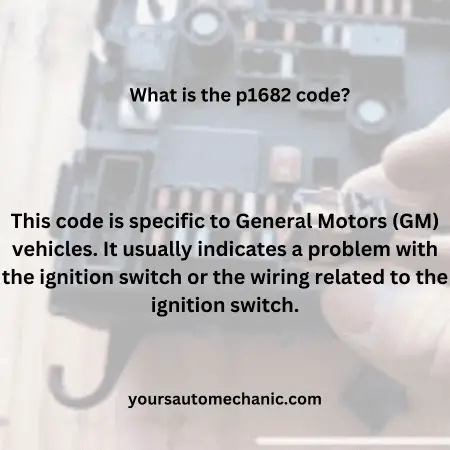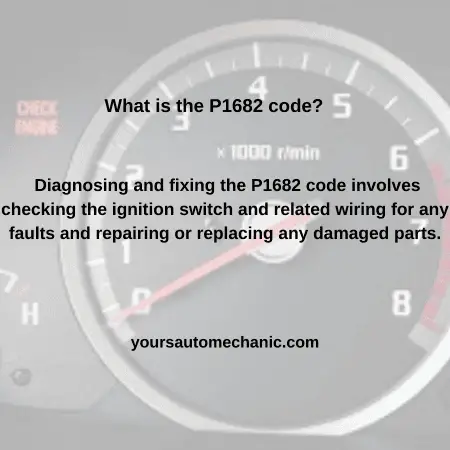Dealing with car issues can be a headache, especially when your dashboard lights up with a cryptic code like P1682. In this article, I will discuss “What is the P1682 code” its symptoms, causes, and how to fix this issue. So keep on reading…

What is the P1682 code?
The P1682 code is an OBD-II diagnostic trouble code (DTC) that stands for “Driver 5 Line 2.” This code is specific to General Motors (GM) vehicles and is associated with the vehicle’s powertrain control module (PCM). The PCM is a crucial component that manages various aspects of the engine and transmission systems to ensure optimal performance and efficiency.
When the P1682 code is triggered, it indicates an issue within the ignition switch circuit, specifically related to the second line of driver number five. This malfunction can lead to several engine performance problems, including difficulty starting the engine, unexpected stalling, or reduced engine power.

Symptoms of “P1682 code”
When the P1682 code is triggered in your vehicle, you’ll notice several symptoms indicating issues in the ignition switch circuit or related components.
Engine Cranks but Won’t Start
One of the most common symptoms you’ll experience with the P1682 code is the engine cranking but failing to start.
This happens because the ignition switch isn’t sending the correct signals to the powertrain control module (PCM), preventing the engine from firing.
Despite the starter motor engaging and the engine turning over, the absence of proper ignition signals results in the engine not starting.
Engine Stalling
You’ll also notice unexpected engine stalling. Your vehicle may start and run for a while, but then suddenly stall without warning.
This stalling can occur at any time, whether your vehicle is idling, accelerating, or cruising at a steady speed.
Reduced Engine Power
When experiencing the P1682 code, you’ll see a noticeable decrease in engine performance.
This symptom, commonly referred to as “limp mode,” is a safety feature that limits the engine’s power output to prevent further damage.
You’ll experience sluggish acceleration and a general lack of power, making driving your vehicle normally difficult.
Hard Starting
In addition to the engine failing to start, you might also experience difficulty starting the vehicle.
This can involve longer cranking times before the engine finally starts or requiring multiple attempts to start the vehicle.
The inconsistency in the ignition switch signal can lead to unreliable starting performance.
Inconsistent Electrical Performance
In some cases, you might notice inconsistent electrical performance, such as flickering dashboard lights or erratic behavior of electrical components.
This inconsistency is due to the fluctuating signals and voltage irregularities caused by a faulty ignition switch or related wiring issues.
Must Read: How To Pass Emissions With A Deleted Diesel – A complete Guide
Causes of the P1682 Code
The P1682 code is a diagnostic trouble code (DTC) that appears in vehicles when there’s an issue with the ignition switch or its circuit. Here are the main causes of the P1682 code:
Faulty Ignition Switch
The ignition switch is a critical part of your car’s starting system. If it’s defective, it may not send the right signals to the engine control module (ECM), leading to the P1682 code.
Damaged Wiring or Connectors
The wires and connectors that link the ignition switch to the ECM can wear out, break, or get loose. Damaged wiring or faulty connectors can disrupt the signal and trigger the code.
ECM Problems
The ECM itself can have issues. If it fails or has an internal problem, it might not communicate correctly with the ignition switch, causing the P1682 code to appear.
Battery Issues
A weak or dead battery can also lead to the P1682 code. If the battery doesn’t provide enough power, the ignition switch and ECM might not function properly.
Corroded or Loose Connections
Corrosion or loose connections in the ignition switch circuit can interrupt the flow of electricity. This interruption can cause the P1682 code to be set.
Aftermarket Modifications
Installing aftermarket parts or making modifications to the vehicle’s electrical system can sometimes interfere with the ignition switch circuit and lead to the P1682 code.
The P1682 code usually means there’s a problem with the ignition switch or its circuit. Checking these components can help diagnose and fix the issue.

Step-by-Step Guide: How to Fix the P1682 Code Issue
Dealing with the P1682 code can be a bit of a hassle, but don’t worry, I’ve got you covered. Here’s a step-by-step guide to help you fix the issue and get your vehicle running smoothly again.
1. Safety First
Disconnect the Battery: Before you dive into any diagnostic or repair work, make sure to disconnect your vehicle’s battery. This will help you avoid any electric shocks or short circuits.
Wear Safety Gear: Don’t forget to put on gloves and safety glasses to protect yourself while working on your car.
2. Read the Trouble Codes
Use an OBD-II Scanner: Plug in an OBD-II scanner to your car’s diagnostic port to read the stored trouble codes. Confirm that the P1682 code is there and check for any other related codes.
Record the Codes: Write down all the codes you find for reference during the repair process.
3. Inspect the Ignition Switch
Locate the Ignition Switch: Grab your vehicle’s service manual to find where the ignition switch is located.
Check for Physical Damage: Take a close look at the ignition switch for any signs of damage, wear, or corrosion.
Test the Switch: Use a multimeter to test the ignition switch for continuity. Follow the instructions in the service manual for the correct procedure.
4. Examine the Wiring and Connectors
Inspect Wiring Harness: Look over the wiring harness connected to the ignition switch for any signs of damage, fraying, or corrosion.
Check Connectors: Make sure all the connectors are secure and free from corrosion or debris.
Repair or Replace: If you spot any damaged wires or connectors, go ahead and repair or replace them.
5. Test the Powertrain Control Module (PCM)
Locate the PCM: Use the service manual to find the PCM’s location in your vehicle.
Check Connections: Ensure all the PCM connectors are secure and free from corrosion.
Test Voltage Supply: Use a multimeter to check that the PCM is getting the proper voltage. Inconsistent voltage can trigger the P1682 code.
6. Check the Battery and Charging System
Test the Battery: Use a multimeter to check the battery voltage. A fully charged battery should read around 12.6 volts. If the battery is weak, charge or replace it.
Inspect the Alternator: Make sure the alternator is doing its job and charging the battery properly. Test the charging system to confirm it’s providing the correct voltage.
7. Clear the Trouble Codes
Reconnect the Battery: Once you’ve done all the inspections and repairs, reconnect the vehicle’s battery.
Clear Codes with OBD-II Scanner: Use the OBD-II scanner to clear the trouble codes from the PCM.
Test Drive: Start your car and take it for a spin to make sure the issue is resolved and the P1682 code doesn’t come back.
8. Re-scan for Codes
Final Check: After your test drive, re-scan the vehicle with the OBD-II scanner to ensure no new trouble codes have popped up.
You MAy Find Helpful
- 7E8 Engine Code – Symptoms | Causes | Troubleshooting
- P0008 Code But Car Runs Fine – Its Causes & Potential Action
- How Do I Fix Code C1201- Step By Step Guide
- What Causes a P0087 Code & How To Fix This Issue
Conclusion
By following these steps, you’ll restore your vehicle’s performance and reliability. If you need help, consult a professional mechanic. Good luck and drive safe!
